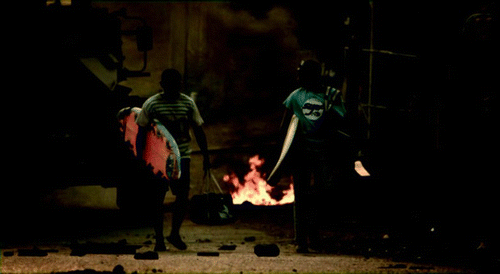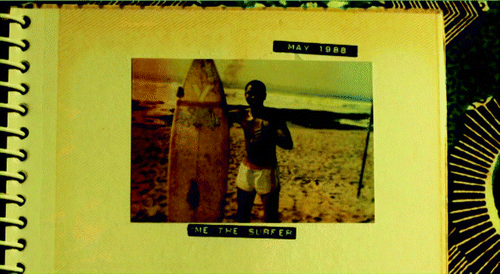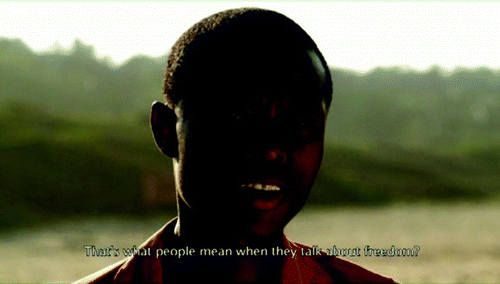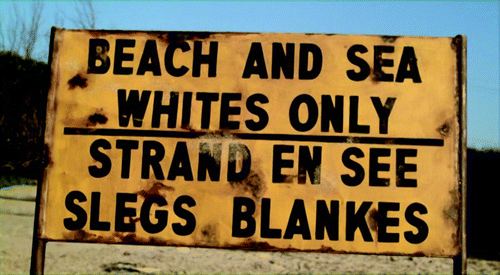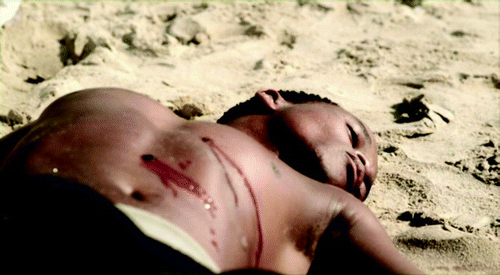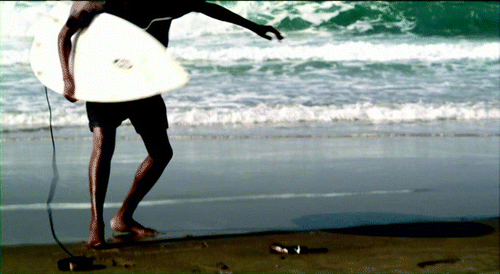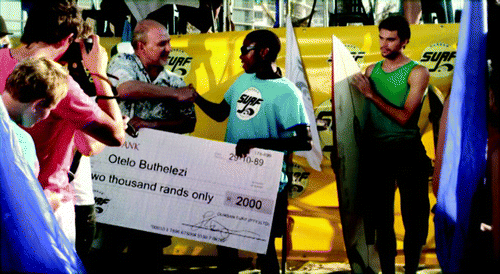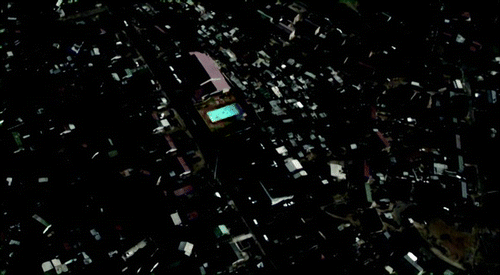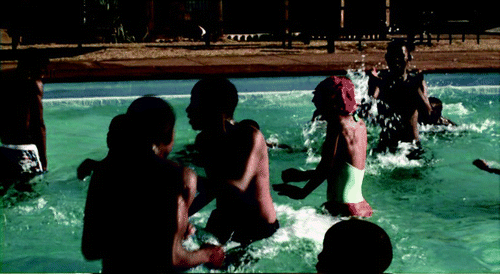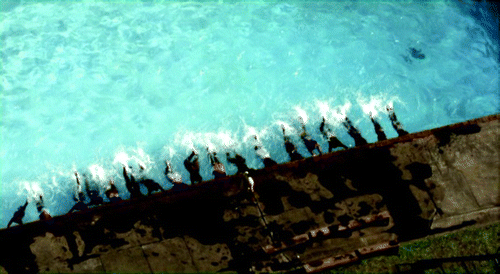Abstract
The feature film Otelo Burning (Citation2011) tells the story of black youth ‘tasting freedom’ by surfing waves in late apartheid South Africa and reflects on the emergence of a new national order by drawing Nelson Mandela's release from prison into its plot. This article situates the film in a genealogy of black-centred representations of Durban beach – including Peter Abrahams's memoir Tell Freedom (1954), Drum photographer Bob Gosani's framing of Dolly Rathebe at a Durban beach (1957), Lewis Nkosi's Mating Birds (1983) and the post-apartheid film Jerusalema (Citation2008) – and in relation to international surfing fiction and film – particularly Kum Nunn's novel trilogy and the films Point Break (Citation1991) and Blue Crush (Citation2002). It focuses on the settings of beach and sea, township and pool and teases out the generic scripts that compose the film. A tension between the attraction of the outlaw figure that informs ‘surf noir’ and the production of the Bildungsheld as normative, ‘responsibilitized’ citizen-subject is found to animate this story of surfing and to direct the questions about freedom that it poses from the vantage point of a democracy itself now coming of age.
Introduction
The feature film Otelo Burning (Citation2011), directed and produced by Sara Blecher, tells the story of black youth ‘tasting freedom’ by surfing waves in South Africa during the death-throes of apartheid. This article explores the ways in which beach and sea, township and pool are respectively produced therein as settings of self-formation and liberation as well as of their undoing or co-option. It advances this enquiry by teasing out two genres that are imbricated in the film's narrative – ‘surf noir’ and the coming of age story – and tracing the ways in which the beach as setting is framed.
Writer and critic Zoë Wicomb suggests that, for the postcolonial author, ‘setting functions much like intertextuality’, opening ‘dialogue between texts’ (Citation2005, 144; 146). Adapting her comment to film, this article reads the beach as a tissue of citations composing Otelo Burning as dialogic text. As limen between land and sea, the beach is moreover a potent site for performing the rites of passage that, in Otelo Burning, have an individual and national referent. Following the narrative structure of the Bildungsroman – the novel of education or development – the film implicitly presents a rite of passage into a democratic South Africa that is in turn incorporated into a neoliberal global order.
But this narrative is in the film troubled by the darker mood of ‘surf noir’ first forged in the fiction of Californian novelist Kem Nunn. Following the publication of his Tapping the Source (Citation1984), the story of surfing grows preoccupied with its implication in damage and begins exposing the underside of sunny beaches and pristine waves, or engaging the blurred boundary between the licit and the illicit in the neoliberal economy.Footnote1 Otelo Burning is infused with this now dominant current in international surf fiction and film that emerged in North America after the Vietnam War to displace the fun-in-the-sun ‘beach blanket’ movies of the early 1960s. The resultant tension between the attraction of the outlaw figure that informs ‘surf noir’ and the production of the Bildungsheld as normative citizen-subject animates this story of surfing set at the emergence of a new South Africa and puts it in service to a series of questions about national and individual freedom: what does it mean and entail, at what price is it attained and how is it derailed or corrupted?
Plot: diegesis, voice-over and photo album
The film's diegesis opens with three boys at a river – a transitive medium between land and sea: the adolescent Otelo (Jafta Mamabolo), his friend New Year (Thomas Gumede) and Otelo's younger brother, Ntwe (Tshepang Mohlomi). New Year's voice-over launches the Otelo Burning narrative by marking the Lamontville township in which they live as a space from which to flee in pursuit of freedom and more expansive horizons.
After Ntwe's near drowning in the river the older boys are invited by the swimming coach Skhumbuzo (Hamilton Dhlamini) to take lessons at the local pool. In the following sequence the filmic syntax of the match cut from a fan inside the shebeen in which New Year lives to a helicopter surveying the streets sets the scene for a depiction of township life as pervaded by militarized violence. The context is of the late 1980s conflicts between African National Congress aligned comrades and Inkatha impis (warriors) that were fanned by an apartheid ‘third force’. It is from the brutality of this surrounding world, as well as the drudgery and degradation represented within the shebeen, that the boys along with New Year's sister Dezi (Nolwazi Shange) seek respite at the Lamontville pool.
The pool is for them a transitional site en route to the beach. There, New Year along with his sister Dezi, Otelo, and Ntwe first encounter what they recognize as ‘freedom’ when they watch Skhumbuzo's nephew, Mandla (Sihle Xaba), surfing. This expansive scene is, however, constricted as the camera draws back to reveal a sign that designates the beach and sea for ‘whites only’. A generalizable coming of age story is thus placed in an exceptional state of exclusion in which everyday life is curtailed by apartheid and the destructive forces it unleashes.Footnote2
Refusing the proscription of the apartheid sign, Otelo and New Year embark under Mandla's tutelage on a journey to become competitive surfers, claiming rights to both the beach and surf. Yet, while rejecting constructions of the beach as a white space, Otelo, Mandla, and New Year find themselves drawn into the world of competitive surfing that, as Glen Thompson has argued elsewhere, was part of the ‘making of a white exemplar masculinity’ under apartheid (Citation2008).
Jealousy simmers as Otelo supersedes Mandla on the waves; it approaches boiling point when Mandla sees Otelo kissing Dezi. When Mandla's board breaks and he is humiliated by the white boy who had previously enabled his access to the surf, his desire to win sees him selling-out: he informs on the comrades to the police; and, when they seek to punish the impimpi (‘informer’), he deflects attention from himself by pointing them to Ntwe.
In a devastating montage sequence, the film splices Otelo's victory at the Regionals surfing competition with the necklacing of Ntwe beside the pool.Footnote3 The distinct worlds of surfing and the township-in-conflict then intersect in the iconic image of Otelo and New Year walking home through burning streets toting their surfboards (see ).Footnote4 The right to the beach that Otelo had finally asserted through his podium position in the surfing competition is overshadowed by the ghastly discovery on their return of Ntwe's remains. Soon after, Mandla completes his transformation from ‘instructor’ to antagonist by raping Dezi.
Identified by Blecher in the interview included in this special section as an unconvincing moment in the plot, the rape scene is designed to push Otelo over the edge. This push aims to establish coherence in a narrative initially composed of what Blecher describes as a ‘chaotic’ tangle of stories that emerged from the script workshops held with lifesavers and surfers who had trained at the featured Lamontville pool.Footnote5 Blecher relates that these stories were then overlaid by the themes of greed and jealousy drawn from the Shakespearian tragedy Othello that direct the film's plot and frame Mandla as an Iago-like character.Footnote6
Assuming initially that the intercourse he interrupts is consensual, Otelo flees the township for Dead Man's Point, where he surfs alone in a sequence expressive of his death-drive until Dezi arrives and tells him that she was raped. Setting off to confront Mandla, Otelo instead finds his broken board and realizes that he replaced rather than repaired it, and had sold out first the comrades and then Ntwe in order to enter the Nationals surfing contest as a better equipped and thus more competitive contender. From this point on, the plot drives steadily towards its tragic denouement: Otelo hitchhikes to the beach where the Nationals are in progress while news of Nelson Mandela's release from prison is broadcast. On his arrival at the competition, he shoots Mandla and runs into the surf with his board, catching one last, glorious ride in which he is finally able to ‘fly like a bird’ before being sucked into the foam.
The final scene, however, transports the film into a brighter future in which New Year has taken up the role of lifesaver and trainer at the Lamontville pool earlier filled by the character Skhumbuzo. ‘As for me’, he says in a final address to the viewer, ‘I always thought that freedom meant getting out of Lamontville, but now I know it's not true. Freedom is right here, carrying on what Skhumbuzo started.’ Apparently Otelo's story, the narrative is here redirected into one that relates New Year's evolution from his initial desire to transcend the township to this immanent conclusion.
The film's structural conceit – introduced during the editing stage rather than pre-scripted, as noted by Blecher in the interview – is that it is New Year's photo album, and that his narration sets the still images in motion (see ). Drawing on Susan Sontag and Roland Barthes's reflections on photography, I suggest below that the moments in which the screen freezes into the still photographs restore into the ‘here-now’ of a democracy that is coming of age in an increasingly cynical state some of the promise and potential for freedom of the ‘there-then’ of the early transition (Barthes Citation1977, 44). At the same time, the still images situate the film in a tradition that includes Bob Gosani's photographs of ‘Jazz Stars at the Beach’ (published in Drum, July 1955) and Cedric Nunn's memorable image of boys bodyboarding at Arniston beach (1989).Footnote7 Both encode beach and sea as sites of black leisure activity and performances of freedom; as does Otelo Burning, they refuse apartheid constructions of ‘black beach-goers as an alien presence on white beaches’ (Durrheim and Dixon Citation2001, 435).
Setting: the beach in black-centred fiction, film, and photography
Teasing out the intertextual threads that compose this setting, this section locates Otelo Burning in a genealogy of representations of the South African beach. The meanings that the film's narrative invests in the beach are evident in its framing between two scenes: the first in which an awed Dezi, New Year, Ntwe, and Otelo observe Mandla's prowess in the water (see ) and recognize that surfing can offer them the freedom they desire before the camera pulls back to include the ‘whites only’ sign (see ); and, the second, where a mortally wounded Mandla bleeds into the sand (see ).
The latter marks a return to the inaugural presence of the South African beach in print culture: Luis Camões's Portuguese imperial-national epic, The Lusiads (Os Lusíadas [Citation1572]), in which the sand is spotted ‘crimson’ with indigenous blood following a first encounter with Europeans that anticipates colonial and apartheid rule. Reiterating this founding moment in its concluding beach scene, Otelo Burning historicizes the South African beach as the setting of violent expansionism. At the same time, this setting places the film in dialogue with a series of black-centredFootnote8 texts that present the Durban beach as an aspirational site from which to imagine, project, or tell freedom under the segregated and apartheid states referenced in the ‘whites only’ sign.
In his memoir of his departure from segregated South Africa in 1939, Peter Abrahams casts the beach as a threshold onto the voyage to ‘tell freedom’. In part a Künstlerroman,Footnote9 Abrahams's Tell Freedom (1954) resonantly approaches this conclusion by relating its subject's first encounter with literature in the form of the story of Othello that a Jewish girl reads to him at work from Charles Lamb's Tales from Shakespeare. Abrahams recalls: ‘I was transported to the land where the brave Moor lived and loved and destroyed his love’. His younger self resolves there and then to go to school: ‘When I can read and write I'll make stories like that!’ (Citation1981, 149–150). However, he learns painfully that regardless of his ambitions or accomplishments, segregated South Africa will bar him on account of his race. The penultimate scene sees him lying on the beach at night after nearly drowning during a swim as he seeks to escape the oppressive conditions of the labour compound in Durban in which he has bedded down en route to his exile. In this threshold space, and at the transitional age of twenty-one years, he reflects:
All my life had been dominated by a sign, often invisible but no less real for that, which said:
RESERVED FOR EUROPEANS ONLY. (Abrahams Citation1981, 310)
Preparing to strike out in search of another state, he concludes: ‘Perhaps life had a meaning that transcended race and colour. If it had, I could not find it in South Africa. Also, there was the need to write, to tell freedom, and for this I needed to be personally free … ’ (Abrahams Citation1981, 311). The last lines see him walking ‘briskly down to the docks. And all my dreams walked with me’ (Abrahams Citation1981, 311). Rather than expressing an escape from history, Abrahams crosses the beach to ‘tell freedom’.
During a visit to report on the prevailing ‘colour bar’ in South Africa in 1952, which inspired him to begin his memoir on return to the United Kingdom, Abrahams was based in the office of Drum magazine. Although financed and edited by whites, Drum became the mouthpiece of black urban South Africa and the ‘social barometer’ of the decade (Chapman Citation2001, 185). (In this respect it might be seen to anticipate Otelo Burning, which is produced and directed by Blecher while composed of stories gathered from workshops on the black beach experience.)
Tell Freedom is in implicit dialogue with a series of photographs by Bob GosaniFootnote10 published in Drum in July 1955 that present ‘Jazz Stars at the Beach!’ The cover presents Dolly Rathebe posing in an image in which the beach is framed to project freedom.Footnote11 Rathebe, a jazz singer, had shot to fame after starring in the first feature film to foreground the black experience in South Africa, African Jim aka Jim Comes to Jo'burg (Citation1949), and became the darling of the Drum set. In 1952 she had posed besides Johannesburg's mine-dumps in a makeshift handkerchief bikini for a Drum photo shoot by Jürgen Schadeberg, transforming these traces of the underground labour producing the city into imaginary pleasure-zones.Footnote12
The 1955 cover shoot apparently seeks to actualize this fantasy as it composes Rathebe in a glamorous yellow bikini on the Durban shore. Behind her, two young black men watch a third running into the surf. The emphasis is on an easy habitation of the beach as accessible leisure site. Rathebe stands in the thin film of water that covers the sand, and laps up on the urban backdrop behind her; it is as if the littoral location opens the city to her at the very moment in which it was being closed to black South Africans.Footnote13 Sophiatown, with which both Drum and Rathebe were closely associated, symbolized a cosmopolitan black urbanity in inner city Johannesburg before being re-zoned for ‘whites only’ in the year before this shoot; the forced removal of black families to regimented townships on the outskirts of the city began just months before in February 1955. The staging of Rathebe – who invests each setting she inhabits with desire – on the Durban beach frames it as an aspirational site that fills the looming gap left by the bulldozing of Sophiatown.Footnote14
By the time erstwhile Drum reporter Lewis Nkosi publishes his novel, Mating Birds (Citation1983), which takes Durban beach as its primary setting, the signs that regulate Abrahams's movements through city-space and erase Drum's Sophiatown have taken up residence on the beach: ‘BATHING AREA – FOR WHITES ONLY!’ (Nkosi Citation1983, 6).Footnote15 Nkosi frames the beach as an ambivalent space that both hyperbolizes the arbitrary separations of apartheid and destabilizes its signs with shifting sands. Consistent with Abrahams and Gosani, the beach remains a site from which Nkosi imagines escaping to ‘distant shores’ from the increasingly oppressive conditions of apartheid, while eliciting a modernist aesthetic that throws meaning into flux and advances ambivalence in relation to the novel's central event – Sibiya's reported rape of a white woman. Inflected perhaps by his long exile, Nkosi's novel is somewhat out of tune with the otherwise pious and Manichean tone of much apartheid-era literature; the moral ambiguity he locates on the beach goes offshore until the post-apartheid film Jerusalema (also known as Gangster's Paradise [Citation2008]) returns to frame the beach in its closing scene.
Written and directed by Ralph Ziman and co-produced with Tendeka Matatu, Jerusalema charts the rise of Lucky Kunene from petty criminal to the ‘Hoodlum of Hillbrow’. Lucky's story begins in 1994 at the dawn of a ‘new’ South Africa. Imbued with ‘dreams’ for a future incarnated in a beach house in Durban with a BMW parked outside, he successfully applies for a place in the School of Business Studies at the local university. But his aspirational path is thwarted by his failure to secure a scholarship, and he embarks instead on his own project of ‘free enterprise’ that holds up a dark mirror to an erstwhile revolutionary state that has abandoned socialist for neoliberal principles.Footnote16 In Robin Hood fashion, he hijacks buildings from absentee landlords in Hillbrow – a densely populated inner city area of Johannesburg – by offering tenants reduced rent and better services. When eventually caught in a police dragnet, he ingeniously escapes prison and flees to Durban, where he plans to continue his illicit career by appropriating seafront apartment blocks.
Reflecting on the meanings of freedom and surfacing the underbelly of the democratic order, Jerusalema is a significant intertext of Otelo Burning. Not only do both end – or almost end in the case of Otelo Burning – on the Durban beach, but the young Lucky Kunene of this filmic anti-Bildungsroman (in that he remains resolutely anti-social) is played by the same actor as Otelo. Jerusalema cannily reveals how, as Jean and John Comaroff note, under the ‘neoliberal mechanisms of deregulation’ into which South Africa enters upon its emergence as post-apartheid state, ‘criminal violence does not so much repudiate the law or the licit operations of the market as appropriate their forms and recommission their substance’ (Citation2008, 5). Lucky Kunene's final words as he stands on the beach just above the waterline are chilling: ‘After every revolution comes a new order, but before that comes opportunity … After all, wasn't it PW Botha who said adapt or die?’
It is significantly at this precise position – on the sand above the waterline – that Otelo drops the gun after shooting Mandla and runs into the sea, leaving the social, civil world behind him (see ). Part of the work of Otelo Burning seems to be to reprise the meaning of freedom away from Jerusalema and reinvest it in the figure of the ‘responsibilitized’ citizen-subject.Footnote17 In order to achieve this, Otelo Burning turns from the beach as setting, with its inherent ambiguity and proximity to the anti-social sea, and reassembles its idea of freedom around the Lamontville pool. However, the narrative of Bildung that concludes at the pool is throughout shadowed by the noir mood of this surfing story.
Scripts: Bildung, noir, and the surfing story
The surfing story as it has been composed in fiction and film from California and Australia typically comprises two generic ‘scripts’: coming-of-age narratives that find expression in the Bildungsroman form; and, the mode of ‘surf noir’. When transported to South African shores, the former is put in service to a national narrative of political transition, while the latter takes literal expression in the figure of the black surfer and taps into a mood of moral ambivalence that seems to have infused South African cultural production at the dawn and in the aftermath of apartheid.Footnote18
In many a ‘surf noir’ plot, surfing is shaded by greed and competition, or the anti-social willingness to pay any price for the ultimate wave. This theme organizes the narrative of the most successful surfing film of recent years, director Kathryn Bigelow's Hollywood feature Point Break (Citation1991).Footnote19 Surfing and the sea are initially shown to offer an alternative and enlivening moral order within a deathly late-capitalist system. As the film's anti-hero Bodhi (Patrick Swayze) puts it when accounting for the bank robbery by which he finances his ‘free-surfing’: ‘This was never about the money, this was us against the system … showing people on the highway that we are still alive.’ Similarly for Otelo and his peers, for whom surfing is freedom and an alternative to both the entrapping logic of apartheid and the violence of (counter)revolutionary activity. However, in both films surfing is steadily implicated in greed and destruction, raising the question: what does the freedom figured in surfing cost?
For all this immanent critique, Point Break grants Bodhi a transcendent end. The finale in which he lives out his code and is swallowed by the sea rather than being captured on land – or ‘paying the price’ for his actions – is echoed in Nunn's Dog's of Winter (Citation1997): once again the ‘surf noir’ anti-hero is engulfed by the ocean. The novel reflects on its denouement: ‘Because surfers loved their stories. Big waves and outlaws. Eccentrics who had managed somehow to beat the system, to stay in the life when others moved inland and paid taxes’ (Citation1997, 360). It is in this tradition that Otelo runs into the ocean after shooting Mandla, rather than being led off the beach in handcuffs. Reiterating the conclusions of Point Break and Dogs of Winter, Otelo Burning casts its penultimate scene in a noir light. Throughout the film the sea extends a glistening, clear blue-green vista; its waters spatter the camera lens to produce brilliant light-spots that render the surfing scenes simultaneously magical and authentic. In the penultimate sequence, however, the sea is dark and malevolent and the camera sinks with Otelo into its obscure depths.
Produced in the wake of Jerusalema, Otelo Burning seems to follow it in returning to a mood that attended the dawn of apartheid, in which film noir and the ambivalent identification with the outlaw figure that it fostered enabled critical reflection on law and order in a context in which urban Africans were criminalized by influx control regulations and the Group Areas or Reservation of Separate Amenities Acts. Perhaps it is no coincidence that this, too, was a cultural moment that sought to claim the beach as a black leisure space. In his memoir, Drum editor Anthony Sampson recalls his revelatory viewing of the classic Hollywood noir film The Street with No Name (Citation1948) in Sophiatown (Sampson Citation1956, 101). Witnessing keen audience identification with the gangster portrayed in this film, while finding that the FBI characters were subject to distracted jeers, Sampson comes to appreciate the inverse moral order that informed Drum during the 1950s.Footnote20
Subsequent literature and films produced under apartheid were drawn rather towards the moral clarity of the fight of right against might. This shift is dramatized in the film Mapantsula (1988), released in the year that the narrative of Otelo Burning begins. In contrast to the ambivalence or approbation with which Drum presented the gangster figure, Mapantsula centres on a gangster's rehabilitation as a political activist. The post-apartheid return to a mood of moral ambivalence is brazenly staged in Jerusalema. Becoming the celebrated Hoodlum of Hillbrow, ingeniously evading detention and ultimately fulfilling his dream of a beach house in Durban,Footnote21 the protagonist and narrator Lucky Kunene is precisely the kind of outlaw figure with whom Drum forged ambivalent identifications.
Rather than reiterating the cynicism of Jerusalema, however, Otelo Burning’s noir undercurrent is critically attentive to the co-option of freedom, and its redirection from a liberatory practice towards an acquisitive subject. When Dezi, New Year, Ntwe, and Otelo first visit the beach to watch Mandla surf, Otelo declares emphatically: ‘That's what people mean when they talk about freedom’. Into this scene steps a white surfer, Kurt, who re-encodes surfing as a means to an end: ‘Hawaii, Pipeline, sponsorship, hotels, room-service, cherries … ’ This chain of prospects both engenders and shackles Otelo's dreams and corrupts Mandla entirely. Here, the international surfing story of professionalization meshes with the South African national narrative. It is precisely to direct it towards this end that the script is overlaid with the tragedy of Othello – a story, as Blecher describes it in one of the ‘sound bites’ included in this section, of ‘greed, jealousy and betrayal’. The message the film seeks to convey through the cautionary narrative of Otelo and Mandla's undoing is – as Xaba elaborates in the same forum – that one must be patient, and work hard for reward.
But the aim of securing surfing sponsorship is not necessarily at odds with this injunction. As in the girl-power Hollywood production Blue Crush (Citation2002) and its set-in-South Africa sequel (released simultaneously with Otelo Burning in Citation2011), the bank-robbing plot of Point Break is in Otelo Burning replaced by the drive for sponsorship. Blue Crush concludes with its attainment, articulating a neoliberal narrative of effort and reward as a hotel chambermaid is signed up by the Billabong surfing label. But whereas Blue Crush airbrushes out noir apprehensions of the surfing industry's collusion in the corruption of what it presents – indeed, markets – as pure, Otelo Burning maintains a critique of this complicity.Footnote22 It makes clear in the conversations between Kurt and the potential white sponsor that extending support to black surfers is the means by which a previously exclusionary white industry can sustain itself beyond the transition without having to examine its own complicity in the ‘whitening’ of South Africa's beaches (cf. Thompson Citation2011; Laderman Citation2014).Footnote23 At the same time, both Blue Crush and Otelo Burning project an exhilarating inspirational affect in the footage they purvey of women and black surfers; while subject to the incorporative effects of the market, both have also in their ‘public lives’ (Modisane Citation2013) opened or extended debate and practice around how the waves are raced and gendered.Footnote24 Blecher talks to this point in one of the ‘sound bites’ included in this special section when she notes the visible increase in women and then black surfers following the respective releases of Blue Crush and Otelo Burning.
In reflecting on Otelo Burning’s simultaneous critique and production of a neoliberal national subject, it is instructive to consider Joseph Slaughter's (Citation2007) compelling discussion of the Bildungsroman, which is typically glossed as ‘the novel of education’. Slaughter finds that the Bildungsroman structure maps out the incorporative process ‘by which historically marginal subjects are to become national citizens’, ‘posit[ing] the nation-state at the highest form of expression of human sociality and the citizen as the highest form of expression of human personality’ (Citation2007, 27, 94). His argument holds significant insights for a reading of Otelo Burning, which adapts the Bildungsroman form to film.
Otelo Burning is staged as a story of education and re-education while set in allegorical relation to a national story convened around the release of Mandela. Emphasizing the centrality of education in its plot is the first appearance on screen of three of the main characters in school uniform while the voice-over opens with a summation of prior communal instruction: ‘Growing up in Lamontville, we were taught to be scared of water’. Much of the film traces Otelo and New Year's remaking as watermen, emphasizing the training of body, mind, and spirit. Following the opening scene and film credits, the voice-over establishes the context of this Bildung and presents the protagonists as subjects requiring re-education: ‘It was 1988 and we thought freedom meant getting out of Lamontville. We were sixteen and we thought we knew absolutely everything.’
As is typical of the Bildungsroman, the story of self entwines with that of society in Otelo Burning. Located in late apartheid and embodied in boys on the brink of adulthood, the coming-of-age story is concerned with questions about freedom and responsibility that are carried by the surfing narrative and addressed to the post-apartheid nation as it revisits a historical moment in which – to quote the film's subtitle – ‘Everything is about to change’. As it grapples with the meanings and implications of freedom, however, it pulls in two directions: projecting a noir narrative shaded by dark undercurrents and infused with moral ambiguity while veering towards the production of the normative, ‘responsibilitized’ citizen.
Slaughter (Citation2007) demonstrates that the postcolonial Bildungsroman can be simultaneously normative and critical. Adapted to the screen it is certainly the vehicle of much critique in Otelo Burning. Most potently, it points to the persistently foreclosed Bildung of black youth and the ways in which society thwarts rather than nurtures their becoming-selves, producing instead violence and death. Of the four male youth who are at the centre of the narrative, only one survives the transition into both adulthood and the new South Africa. To emphasize this devastating outcome, Otelo Burning locates the untimely ends of its characters in ostensible leisure locations and at pivotal years: Ntwe is necklaced besides the pool a week before his 13th birthday; Mandla is shot on the beach in his early adulthood; and, Otelo disappears into the ocean shortly before he turns 18.
Otelo initially performs the Bildungsheld's progress as he trains first to enter the ocean and then moves from the margins of the beach at the Localism surfing competition to centre-stage at Regionals when he wins first prize (see ). But his return to a smoldering township derails the process of his incorporation into the white-dominated world of competitive surfing. The critique issued in these truncated or diverted trajectories partly reflects the violence that marred the early political transition into a democratic state. It is also anticipatory as it projects forward through a darkened lens to a ‘new’ South Africa that offers limited life opportunities to black youth growing up in townships (70% of whom are today unemployed and unable to secure the trappings of adulthood).Footnote25
The critique is potently expressed through the photo-album conceit that structures the film. In these inserts the ‘flow of time’ through the motion picture freezes into the still photograph (Sontag Citation2008, 111). Sequential time is interrupted by its ‘future anterior tense’, which relays ‘less the present moment than the perspective, the pathos, of a time in which “this will have been”’ (Barthes Citation1982, 97). This pathos attends the protagonists – who are recorded at their most exhilarating or joyful moments – while also being political. Like the archival sound footage of Mandela's release spliced into Otelo's revenge trip, they convey into a more cynical and confusing national present both the thrill and promise of that moment of potential and the sense of its utter pastness. Conjuring the ‘return of the dead’ (Barthes Citation1982, 9), the sound footage and still photographs (the one archival and the other fictional) remind a nation of what it once thought it could become.
The final frame: New Year at the Lamontville pool
Otelo Burning does not end on the denouement of the penultimate sequence with Mandela's release, Mandla's death, and Otelo's last wave. In conclusion, it shifts attention from the protagonist-antagonist dyad of Otelo and Mandla to the narrator, New Year. Through a match cut the camera descends into the ocean with Otelo and then surfaces in the Lamontville pool where this story of change began. From the side of the pool New Year prepares a new generation for their first swimming lesson. The scene is evidently set in the ‘new’ South Africa: New Year is markedly older and sporting a beard. The film concludes as the camera draws up into the sky. The final frame is an aerial shot of a crystal-clear blue pool in the midst of the brown township; says Blecher: ‘the film was designed around that image’ (see ).
Township, beach, and sea are ultimately not settings in which this narrative can achieve closure. The township has been too extensively associated with violent masculinities that prey on women and the young. The beach can neither be reprised from its colonial histories of bloody conflict nor from its apartheid histories of exclusion: as Skhumbuzo, New Year, and Dezi surround the dying Mandla and watch Otelo's final flight, viewers are presented with a mise-en-scène of a bloodied beach dominated by white figures. Echoing Nkosi's earlier novel, Otelo Burning suggests that the beach is a setting in which the black subject is driven towards tragic conclusions. The sea itself, which earlier in the film glistens brightly, is here recast as an ominous, anti-social domain. When Otelo is submerged in the ocean, the film is poised to follow Point Break and Dogs of Winter to a noir conclusion: the camera is sucked underwater along with Otelo, drawing viewers into a dark submarine realm. But then the noir mood is shattered as the camera re-emerges out of the clarity of the Lamontville pool, framing New Year in a new future.
Until this point it appears that New Year is merely witness to and narrator of Otelo's story. At the outset he presents himself in an aside – ‘By the way, I'm New Year, and this is my life.’ However, in the final scene it becomes clear that he and not Otelo is the Bildungsheld. This effectively grants him the ‘right to narrate’ that unbeknownst to the first-time viewer organizes the direction of the film into what Slaughter describes as
the plot of the idealist, affirmative Bildungsroman, which narrates the normative story of how the natural and the individual might become civil and social – the story of how the individual will partakes of the general will without the recourse to social coercion (Citation2007, 9, 26).
It is this plot that reorients viewers away from the image of Otelo, dwarfed by the uncivil immensity of the ocean, and towards the social scene of the pool. Simultaneously, it restores the pool from the violence and coercion both Inkatha and the comrades enact beside it, reclaiming it as a site of socialized self-expression.
The pool is, of course, the setting in which the idea of freedom is first broached in the diegesis as it is here that Mandla invites the others to watch him surf. In this earlier scene it is framed also as the location of everyday black leisure culture under apartheid (see ). In his own memoiristic essay on growing up in the township of Katlehong near Johannesburg, Jacob Dlamini (Citation2009) suggests that the kind of reflective nostalgia for ‘ordinary’ township experiences that attends the early scene of the pool party in Otelo Burning can offer resources for the future. This is precisely what New Year articulates when he abandons his dreams of escape in favour of finding a freedom immanent to the township: taking up Skhumbuzo's work and training a new generation to swim while enabling them also to have fun. As he says in his address to the children lined up on the edge of the pool: ‘This pool here can give you a future. Are you sure you want to go in?’ They respond with the film's final, affirmative word: ‘Yes!’ Again the camera plunges into water, following them as they jump in; this time, however, it is clear and blue. In the final frame, then, freedom is no longer identified with escape from the township, but invested rather in the cool, blue spaces immanent to it that function as ‘portals to other worlds’, as Blecher notes in the interview; it enables access without suggesting flight, which the beach-as-threshold intimated to Abrahams and Nkosi.Footnote26 In this respect, the film evidences a significant shift from apartheid to the post-apartheid.
Cleansed of its prior noir apprehensions in a dramatic turn away from the moral ambiguity embodied in Jerusalema's Lucky Kunene, Otelo Burning instead follows the Bildungsroman structure towards ‘reformist, rather than revolutionary’ conclusions (Slaughter Citation2007, 115). The regulated yet joyful scene of children receiving swimming instruction places the emphasis on a non-regimental discipline that is meant to stand in contrast to both Inkatha ‘marching as one man’ and the comrades as they toyi-toyi around Ntwe's smoldering remains. Thus does the film promote the ‘social individual’ (Slaughter Citation2007, 19) who is neither the anti-individualistic revolutionary subject, nor the surfer as individualistic anti-hero. Instead, the figure on whom it comes to rest is the ‘responsibilitized’ citizen-subject of the lifesaver.
In contrast to Otelo's performance of uncontained freedom in the surf, the closing sequence imagines a nation born out of the negotiated settlement and ‘harmoniz[es] … the individual and the state’ (Slaughter Citation2007, 91). If Abrahams's and Nkosi's protagonists are regulated by an oppressive state, Otelo Burning concludes with a scene in which the children of a democratic order are prepared by New Year for the task of self-regulation.Footnote27 Subjectivity is re-plotted from subjugation towards the rights-and-responsibility bearing subject of citizenship.
The pool, however, also works against this determining narrative. As leisure location it retains a residue of the unfettered energies that inform both the otherwise antipathetic understandings of freedom espoused by the surfers and the revolutionary Blade; as a body of water, albeit contained, it draws into the final frame the exhilarating earlier surfing sequences that remain in excess of the regulatory plot. The yellow shirt that encodes New Year as regulatory figure – the lifesaver – recalls the ebullience of Dolly Rathebe as presented on Drum's cover in a yellow bikini, while the riotous glee of the children splashing wildly in their prescribed formations suggests exuberant energies not entirely constrained (see ).
Notable, also, is the gender parity of this last scene. Whereas earlier in the film boys and girls both trained and partied around the pool, the water itself was restricted for male use. In this last sequence they enjoy equal access to it. This too is a recovery of some of the uncontained energies Dolly Rathebe embodies as she is framed standing not on the sand but in the film of water that covers it. This is in contrast to Dezi, who in the film never crosses the boundary between land and sea. If, as Waitt argues in another context, ‘normative gender scripts are made, and remade, in and through surf spaces’ (Citation2008, 77), the pool in Otelo Burning enables the emergence of new femininities and new masculinities into the post-apartheid landscape.
Viewers are informed during the film's second sequence that Dezi, too, wishes to escape her circumstances, just like Otelo and New Year. But her desires cannot be accommodated in a script that frames her simultaneously as spectator of male prowess and object of the possessive male gaze. Initially, she participates in the training that takes place around the pool, and seems an active subject as through attention-attracting sunglasses she admires Mandla's swimming and agrees to accompany him to the beach to watch him surf. There, however, any ambiguity in her role is erased as she finds herself included as ‘cherry’ (the South African slang equivalent of ‘chick’) in Kurt's list of rewards that await the successful competitive surfer. From here on she is shifted to the margins of the plot, even as it follows the incorporative logic of the Bildungsroman; indeed, it is precisely this logic that renders her available to the imperatives of male character-formation as the film re-directs itself from a noir to a neoliberal narrative by framing Mandla as a rapist. The final scene organized around New Year then reframes masculinity as nurturing while the mixed groups of boys and girls under his tutelage orient the film towards new futures and new narratives.
Conclusion
Otelo Burning claims access to the beach and surf for its youthful characters who experience themselves as trapped in Lamontville township during the dying days of apartheid. Poised on the brink of adulthood and of a democratic rather than exclusionary state, their rites of passage are derailed by uncivil forces both internal and external to them. Representational practices associated with the genre ‘surf noir’ infuse the narrative with a mood of moral ambiguity. At the same time, the film adapts the Bildungsroman structure to screen to forge citizen-subjects for the democratic order.
These two generic ‘scripts’ are uneasily and incompletely merged in Otelo Burning. Each remains in excess of the final synthesis, pulling the film in different directions and enabling fugitive meanings to surface and unsettle the norms of the other. On the one hand, the surfing story is made to confront the exclusions in which it has been complicit; on the other hand, the Bildungsroman's drive towards responsibilitized subjects is troubled by the outlaw beloved of noir plots. Knotting these two variant scripts in a conclusion convened around a contained body of water that glistens in the midst of Lamontville township, Otelo Burning suggests simultaneously the regulation and residue of revolutionary energies and subjectivities in a new state.
Notes
† During August 2013, Glen Thompson and I interviewed director and producer Sara Blecher and actor and waterman Sihle Xaba (who performs the role of Mandla in the film, while aspects of both Otelo and New Year's stories are loosely based on his experiences) and held a series of screenings and Q&As with audiences at the University of Cape Town, Muizenberg, and Khayelitsha. This article is informed by these discussions, edited versions of which are included in this special section. Whereas the companion piece by Thompson contextualizes the film within histories and documentaries of surfing and the beach in South Africa, this article seeks to locate it in relation to international surf fiction and film, on the one hand, and South African textual and (audio)visual culture, on the other. This work is based on the research supported in part by the National Research Foundation (NRF) of South Africa (Grant Number 87809). Opinions, findings, and conclusions or recommendations expressed herein are those of the author and the NRF accepts no liability whatsoever in this regard.
1. Krista Comer has usefully attended to surfing's appropriation as ‘globalist trope’ that ‘suggests that the social possibilities generated by the circulation of international capital, new information technologies, and people in transit will prove freeing, much as board surfing is popularly understood to be freeing. Surfing thus constitutes a rhetoric of optimism about the potential of globalization to advance the global good’ (Citation2010, 13). Paddling against this globalizing current, Nunn and others emplot surfing in order to render the dark side of the global order, while in Breath (2008) Australian Tim Winton produces a surfing story of (self)damage shadowing successful Bildung.
2. On the stereotypical or limiting nature of this depiction of black everyday life, see the response by Bheki Peterson in this section.
3. ‘Necklacing’ is a form of popular execution in which a car-tyre is placed around the victim – like a macabre necklace – and set alight.
4. A still of this scene was used as the cover image of the 2013 issue of the journal Shakespeare in Southern Africa. All the stills from Otelo Burning in this article are reproduced with the permission of director and producer Sara Blecher.
5. On the script workshops, see the interview with Blecher and Xaba included in this special section; for a social history of the Lamontville pool and the lifesavers who trained there, see Crispin Hemson (Citation2001).
6. On the film's divergence from the tragedy formula, see the response by David Johnson in this special section.
7. For Gosani's photograph, see: http://jurgenschadeberg.com/galleries/TheBlack_WhiteFiftiesinSouthAfrica/BW50s_101.htm; for Nunn's photograph, see: http://www.cedricnunn.co.za/essays/then-and-now.html or http://mg.co.za/article/2012-05-11-cedric-nunn-riding-the-wave-on-the-cusp-of-sweeping-change.
8. I take the idea of ‘black-centred’ from Litheko Modisane's recent study South Africa's Renegade Reels (Citation2013) as a way of bringing together texts produced or financed by white directors or capital but composed of and centring black stories; white-directed framings of black experience; and collaborative black and white productions or black-produced works.
9. A subgenre of the Bildungsroman, the Künstlerroman narrates the maturation of the artist.
10. The first black professional photographer, Gosani anticipates the series of ‘firsts’ that the film and its paratexts highlight: Mandla and Otelo as (fictional) first black competitive surfers; Mandela as (factual) first black president; and Sihle Xaba as (factual) first black competitive bodyboarder.
11. For the Drum cover featuring Gosani's photograph, see: http://jurgenschadeberg.com/galleries/TheBlack_WhiteFiftiesinSouthAfrica/BW50s_92.htm.
12. See: http://jurgenschadeberg.com/galleries/TheBlack_WhiteFiftiesinSouthAfrica/BW50s_86.htm and http://jurgenschadeberg.com/galleries/TheBlack_WhiteFiftiesinSouthAfrica/BW50s_87.htm.
13. This is implicitly located within the spectrum of fictionalized self-fashioning in which Drum peddled: the original black and white photograph has been colour-tinted and touched up; in its colour manifestation, it looks almost as if the swimmer is about to jump on a surfboard, and in the backdrop the high-rise beachfront buildings have been sketched in.
14. On Sophiatown and Rathebe as aspirational figure, see Samuelson (Citation2008).
15. In 1960 the majority of the country's beaches were, like many of its urban and rural spaces, also declared for white use only; beach apartheid ended only in 1989 (see Durrheim and Dixon [Citation2001]).
16. The protagonist and film, notes Dawid de Villiers, ‘symbolically collapse the historical dialectic of revolution into the non-eschatological present of global capitalism’ (Citation2009, 10).
17. The concept is Charles Taylor's, and it informs Slaughter's (Citation2007) discussion of the Bildungsroman that shapes my later argument; I encountered it first in lectures by Wendy Brown at the Johannesburg Workshop in Theory and Criticism (2010) – it was a season of ‘service delivery’ protests preceding the violent repressions of Marikana, and Brown commented approvingly on a strong civil society with vestiges of revolutionary energy that in South Africa still sought to hold the state responsible, rather than accepting the privatization and redistribution of responsibility to its citizens, as Brown observes to have been the case in the United States.
18. For the Californian surfing coming-of-age narrative, see Gidget (novel [Citation1957] and film [Citation1959]), John Milius's Big Wednesday (1978), Kem Nunn's Tapping the Source (Citation1984), Joy Nicolson's The Tribes of Palos Verdes (Citation1998) and, from Australia, Ed Aldridge's coming-out feature Tan Lines (Citation2007) and Tim Winton's novel Breath (Citation2008). Forging the mode of ‘surf noir’, Nunn's trilogy – Tapping the Source, Dogs of Winter (Citation1997), and Tijuana Straits (Citation2004) – exploits an evocatively contradictory landscape of cresting, pristine waves and belching oil wells, inaccessible beaches and impoverished reserves, polluted waters and policed borders. Crime writer Don Winslow, in The Dawn Patrol (Citation2008) and The Gentleman's Hour (Citation2009), and Nicholson's The Tribes of Palos Verdes (Citation1998) take up the mode in order to expose the seedy, exploitative underside of sunny SoCal as property speculators, human traffickers, and drug runners exploit the blurred boundary between the licit and illicit in the neoliberal order. In the documentary tradition, recent exposés of drug-running surfers financing their pursuit of waves by inflicting damage on other lives or of conflicts between equally aggressive localisms and globalisms that culminated in the commercialization of surfing include Sea of Darkness (Citation2013) and Bustin’ Down the Door (Citation2008). The appropriation of free surfing by consumerism and competition informs many a surf noir plot, including the wacky HBO series John from Cincinatti (Citation2007) (co-written by Nunn) and even that of the lightweight and decidedly bright Surfer, Dude (Citation2008).
19. In Point Break a group of surfers rob banks to finance free-surfing. While they remain modest in their takings, no one is hurt; but when they grow greedy death ensues.
20. See also Fenwick's (Citation1996) discussion of the gangster figure in Drum.
21. See De Villiers (Citation2009) on the shift that takes place between the films Mapantsula and Jerusalema.
22. This critique apparently cost it dearly. In her interview, Blecher notes the challenges of securing funding and support for Otelo Burning from the local surfing industry, which she claims instead channelled its resources towards the affirming rather than critical international production, Blue Crush 2 (Citation2011).
23. An earlier version of the screenplay underlines this critique of surfing's complicity in its own commodification by framing the denouement on the beach at Nationals with ‘The branding: Gunston 500. Life Cigarettes. Vote Toothpaste’.
24. Litheko Modisane's recent study of ‘black-centred films’ usefully draws attention to the ways in which they ‘stimulate public critical engagements’ (Citation2013, 2), hence his exploration of their ‘public lives’ to which I allude here. Blue Crush sparked a series of debates in the North American media about women's place in surfing, and the screenings of Otelo Burning in Cape Town that formed part of the preparation of this special section were also taken up as forums to reflect on black surfing and indeed the meanings of blackness in South Africa today. As surfing is more an embodied rather than deliberative practice, the ‘public life’ of the film is also evident in the growing numbers of young black surfers taking to the water in its wake.
25. The resonance between this story of the late apartheid years and the present experiences of township youth was explicitly noted by participants in the screening and discussions we held at Khayelitsha and Muizenberg in Cape Town. One respondent at the screening at Esengweni High in Khayelitsha says: ‘I want to thank you for this movie … everything that was shown in this movie happens here in Cape Town. You find gangsters fighting here in Khayelitsha and even today, there was a fight … ’ (‘sound bites’). Rather than documenting a past and marking the rupture of 1994, the represented world is for these learners part of a continuum they inhabit in townships today. For them, political violence and apartheid deprivation segue seamlessly into gang violence and post-apartheid deprivation on the margins of Cape Town, the ubiquity of which is suggested in the fact that the school in which the screening was held was temporarily closed following shooting in the near vicinity; students returned in the wake of this quotidian spectacle to watch the film. Other continuities are evident in stories of parental neglect, substance abuse, and violence that emerged in the discussions, and in racist incidents experienced by the cast during the filming (see ‘Interview’). One of the most affective scenes in the film – when Otelo and New Year playfully comfort Mandla following his humiliation by a white youth – was shot immediately after one such incident, with the actors improvising the script to convey their own hurt and perform the reconstruction of a subject shattered by racism. Another improvised addition by the actors is the scene in which Blade and New Year discuss their respective understandings of freedom; as the single reflective scene available to Blade's character it helps to expand the limited black subjectivity critiqued by Bheki Peterson in his response to the film.
26. This imminence is literally articulated in the film through its choice of language: the local isiZulu rather than the international English.
27. See Slaughter on the ‘movement of the subject from pure subjection to self-regulation’ in the ‘plot trajectory’ of the Bildungsroman (Slaughter Citation2007, 9).
References
- Abrahams, Peter. (1954) 1981. Tell Freedom. London: Faber and Faber.
- Alderidge, Ed, dir. 2007. Tan Lines. DVD. UK/Australia: Peccadillo Pictures.
- Barthes, Roland. 1982. Camera Lucida: Reflections on Photography. Translated by Richard Howard. New York: Hill & Wang.
- Barthes, Roland. 1977. Image-Music-Text. Translated by Stephen Heath. Glasgow: Fontana/Collins.
- Bigelow, Kathryn, dir. 1991. Point Break. DVD. Los Angeles: Largo Entertainment.
- Bindler, SR, dir. 2008. Surfer, Dude. DVD. Los Angeles: Berk/Lane Entertainment.
- Blecher, Sara, dir. 2011. Otelo Burning. DVD. South Africa: Sara Blecher & Cinga Films.
- Camoes, Luis Vaz de. (1572) 1997. The Lusiads. Translated by Landeg White. London: Oxford University Press.
- Chapman, Michael. 2001. “More than Telling a Story: Drum and its Significance in Black South African writing.” In The Drum Decade: Stories from the 1950s, edited by Michael Chapman, 183–232. Pietermaritzburg: University of Natal Press.
- Comaroff, Jean, and John Comaroff. 2008. “Law and Disorder in the Postcolony: An Introduction.” In Law and Disorder in the Postcolony, edited by Jean and John Comaroff, 1–56. Chicago: University of Chicago Press.
- Comer, Krista. 2010. Surfer Girls in the New World Order. Durham: Duke University Press.
- De Villiers, Dawid. 2009. “After the Revolution: Jerusalema and the Entrepreneurial Present.” South African Theatre Journal 23: 8–22. doi: 10.1080/10137548.2009.9687899
- Dlamini, Jacob. 2009. Native Nostalgia. Johannesburg: Jacana.
- Durrheim, Kevin and John Dixon. 2001. “The Role of Place and Metaphor in Racial Exclusion: South Africa's Beaches as Sites of Shifting Racialization.” Ethnic and Racial Studies 24 (3): 433–450. doi: 10.1080/01419870020036738
- Elliot, Mike, dir. 2011. Blue Crush 2. DVD. Florida: Universal Studios.
- Fenwick, Mac. 1996. “’Tough Guy, eh?’: The Gangster-Figure in Drum.” Journal of Southern African Studies 22 (4): 617–632. doi: 10.1080/03057079608708515
- Gosch, Jeremy, dir. 2008. Bustin’ Down the Door. DVD. Los Angeles: Fresh & Smoked.
- Hemson, Crispin. 2001. “Ukubekezela or Ukuzithemba: African Lifesavers in Durban.” In Changing Men in Southern Africa, edited by Robert Morrell, 57–73. Pietermaritzburg: University of KwaZulu-Natal Press.
- Keighley, William, dir. 1948. The Street with No Name. DVD. Los Angeles: Twentieth Century Fox.
- Kohner, Frederick. (1957) 2001. Gidget. New York: Berkley Publishing Group.
- Laderman, Scott. 2014. Empire in Waves: A Political History of Surfing. Berkeley: University of California Press.
- Milius, John, dir. Big Wednesday. DVD. Los Angeles: A-Team.
- Milch, David and Kem Nunn. 2007. John from Cincinnati. DVD. New York: HBO.
- Modisane, Litheko. 2013. South Africa's Renegade Reels: The Making and Public Lives of Black-Centred Films. New York: Palgrave MacMillan.
- Nicholson, Joy. 1998. The Tribes of Palos Verdes. New York: Macmillan.
- Nkosi, Lewis. (1983) 1987. Mating Birds. Johannesburg: Ravan.
- Nunn, Kem. (1984) 2012. Tapping the Source: A Novel. New York: Scribner.
- Nunn, Kem. 1997. Dogs of Winter. New York: Scribner.
- Nunn, Kem. 2004. Tijuana Straits. New York: Simon and Schuster.
- Oblowitz, Michael, dir. 2013. Sea of Darkness. DVD. Los Angeles: Deco Entertainment.
- Sampson, Anthony. 1956. Drum: The Making of a Magazine. Johannesburg: Jonathan Ball.
- Samuelson, Meg. 2008. “The Urban Palimpsest: Re-presenting Sophiatown.” Journal of Postcolonial Writing 44 (1): 63–75. doi: 10.1080/17449850701820764
- Schmitz, Oliver, dir. 1988. Mapantsula. DVD. Johannesburg: David Hannay Productions.
- Slaughter, Joseph R. 2007. Human Rights, Inc.: The World Novel, Narrative Form, and International Law. New York: Fordham University Press.
- Sontag, Susan. (1977) 2008. On Photography. London: Penguin.
- Stockwell, John, dir. 2002. Blue Crush. DVD. Los Angeles: Universal Pictures and Imagine Entertainment.
- Swanson, Donald, dir. 1949. African Jim. DVD. Johannesburg: Warrior Films.
- Thompson, Glen. 2008. “Judging Surf Culture: The Making of a White Exemplar Masculinity during the 1996 Natal and South African Surfriding Championships held in Durban.” Journal of Natal and Zulu History 26 (1): 81–109.
- Thompson, Glen. 2011. “‘Certain Political Considerations’: South African Competitive Surfing During the International Sports Boycott.” The International Journal of the History of Sport 28 (1): 32–46. doi: 10.1080/09523367.2011.525301
- Waitt, Gordon. 2008. “‘Killing Waves’: Surfing, Space & Gender.” Social & Cultural Geography 9(1): 75–94. doi: 10.1080/14649360701789600
- Wendkos, Paul, dir. 1959. Gidget. DVD. Los Angeles: Columbia Pictures.
- Wicomb, Zoë. 2005. “Setting, Intertextuality and the Resurrection of the Postcolonial Author.” Journal of Postcolonial Writing 41 (2): 144–155. doi: 10.1080/17449850500252268
- Winslow, Don. 2008. The Dawn Patrol. New York: Random House.
- Winslow, Don. 2009. The Gentleman's Hour. London: Heinemann.
- Winton, Tim. 2008. Breath. London: Picador.
- Ziman, Ralph, dir. 2008. Jerusalema. DVD. Johannesburg: Muti Films.

